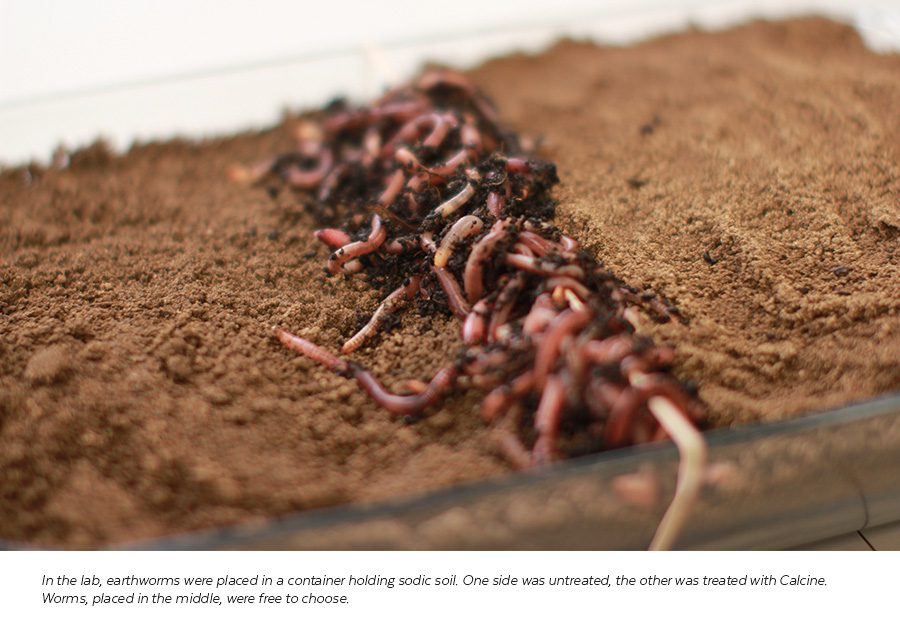Calcine®-treated irrigation water mobilizes salt out of the root zone and improves soil structure. In field trials, these improvements were evident by establishment of earthworms in previously inhospitable soil. In the lab, earthworms also showed strong preference for soils with Calcine-treated water. Earthworms further magnify the beneficial effects of Calcine by improving soil structure and nutrient cycling.
On the farm and in the lab, Calcine-treated water has improved soil structure by reducing soil sodium levels, enhancing permeability and improving infiltration. As a reflection of the soil improvements facilitated by Calcine, earthworm populations in treated soils increased. In fields once sealed and inhospitable to soil life, earthworms were now able to flourish. Earthworms are known to improve soil structure and increase nutrient cycling. Together, these effects can lead to an astounding 25 per-cent increase in yield and a 21 percent rise in plant biomass.1
U.S. farms often have very low worm populations in their soils — a common symptom of poor soil health. By improving soil structure with Calcine, producers can strengthen earthworm populations and better leverage soil organic matter to improve nutrient efficiency — particularly nitrogen — and boost crop yield.
In-Field Findings: Calcine Supports Earthworm Establishment
When added to irrigation water, Calcine has been shown to support dramatic increases in earthworm populations. Calcine-treated water mobilizes salt out of the root zone, which improves soil structure and encourages earthworm establishment. Earthworms, in turn, further improve soil structure and release nutrients, resulting in higher plant productivity.1
2016 field studies on sodic soils in Arizona clearly demonstrate earthworm establishment on Calcine-treated fields. The study analyzed individual plots on two adjacent fields in Buckeye, AZ. One set of plots was irrigated with Calcine-treated canal water; the other was irrigated with untreated canal water. Only a single earthworm was located in one of nine untreated plots; the other eight plots showed no earthworms. In comparison, earthworms collected from Calcine-treated plots averaged 123 worms per square meter.
Earthworms were counted using a standard protocol involving crushed mustard seed dissolved in water. The substance was applied to the soil, causing worms to move to the soil surface where they were counted for 20 minutes. Findings from each treatment plot are summarized in Table 1.

In-Lab Findings: Earthworms Prefer Calcine-Treated Soil

Earthworm preference for soils treated with Calcine was further validated by in-lab studies. In two studies with juvenile and mature earthworms, worms preferred Calcine-treated soils.
In the study, soil treated with water was placed in a container adjacent to soil wetted with Calcine-treated water. Earthworms were placed in the center of the container, allowing worms to migrate freely to either the treated or untreated soil. The container was placed in a 50 degree incubator and misted once daily. After 72 hours, the soil was separated into treated and untreated containers and sieved for earthworm counts. In both cases, earthworm preference for Calcine-treated soil was dramatic. Findings are reported below.

Earthworms Matter.
Earthworms are a leading indicator of soil health. A meta-analysis of 58 studies spanning 100 years showed earthworm presence significantly increased crop yield by 25 percent and plant biomass by 21 percent.1
As part of the larger soil ecosystem, earthworms are essential players in nutrient cycling, residue decomposition, and soil drainage and permeability. Because some agricultural practices, including heavy tillage and irrigation with salty water, can discourage earthworm establishment, it’s important to limit harmful effects when possible.
When added to irrigation water, Calcine helps amend sodic soils and its associated growing challenges — few, if any, earthworms, sealed soils, poor soil permeability and reduced crop productivity.
